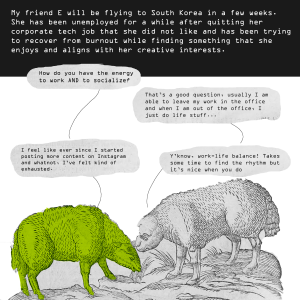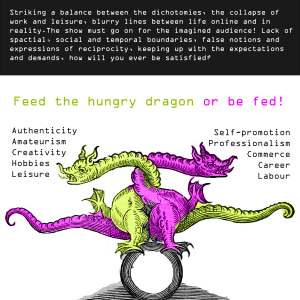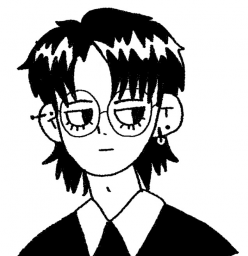Brief
Based on a close reading and careful analysis of Kate Crawford’s chapter on “Labour” in her book Atlas of AI. Identify and describe, in her terms, a kind of work you regard as “digital labour”. Illustrate your observations, with examples and ideas drawn from the readings.
Use any cartoon-creation/animation software of your choice to communicate your understanding of how, why and in what ways work today has revived older practices of industrial labour exploitation, especially on the role of AI in this reversal.
Preface
Drawing upon a conversation through text with my friend E, it made me reflect on her experience of creating online content in relation to ideas that I was reading about in this module about Digital Labour. That was the starting point to creating this collage comic about some of the connecting concepts and theories to what she was going through.
For this project, I decided to use a collage comic as the medium for a few reasons:
Collage Imagery
Drawing from the different readings in this module, it resembles a montage of concepts, akin to a collage where individual ideas are layered and interconnected with each other. I wanted to use juxtaposition of imagery and text to create a meme-like image similar to “content” that one would see on social media, as a critique yet participation in “content-creation” as a form of sharing of ideas.
Woodcut Printing and Pop Art
I chose to use woodcut-printing of imagery as this technique of printing can be mass produced due to the division of labour in the creation process such that artists can adapt to the medium easily without needing to learn the use of woodworking skills. Usually prints are described as “designed by” rather than “by” an artist, highlights the invisible labour from woodworkers and printers that carve the actual blocks, yet go uncredited.
I chose to use bright neon blocks of color reminiscent of the pop-art movement as the philosophy of pop-art not only celebrates the imagery and symbols of mass culture (i.e. advertisements, consumer products, etc.) they also critique the consumerist nature of society. This movement also challenged elitist notions of art by blurring boundaries between high and low culture, making art more accessible to a wider audience and thus democratizing the art. I think this parallel can be drawn to how social media democratizes many aspects of production and distribution of labour.






References
All images are sourced from the public domain archives of the British Library.
Crawford, K. (2021). Atlas of AI: Power, Politics, and the Planetary Costs of Artificial Intelligence. New Haven: Yale University Press. https://doi.org/10.12987/9780300252392
Duffy, B.E., (2017). (Not) Getting Paid to Do What You Love: Gender, Social Media, and Aspirational Work. Yale University Press. http://www.jstor.org/stable/j.ctt1q31skt
Gandini, A. (2021). Digital labour: an empty signifier? Media, Culture & Society, 43(2), 369-380. https://doi.org/10.1177/0163443720948018
